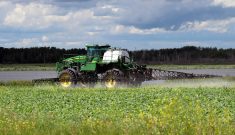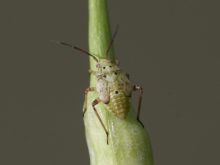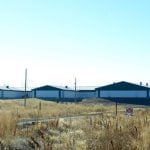Most farmers today recognize the necessity of managing agricultural waste such as empty containers, bags and baler twine — they don’t want to throw it in a ditch to deal with later because that time may never come. On the other hand, it’s one of many things that need to be dealt with on a farm operation — and that can lead to frustration.
Cleanfarms, a Canada-wide environmental stewardship organization, can help producers with questions or difficulties managing ag waste on their farms. One of its key tools is its free recycling collection bags available at its 1,400 partner-run collection sites across the country. Farmers can store their empty, plastic fertilizer and pesticide jugs (and in Western Canada, seed, pesticide and inoculant bags) in them until they’re ready to return them for recycling.

“We have different collection bags for different products depending on the programs we operate but for, say, the 10-litre pesticide containers, those bags are large enough to store 35,” says Cleanfarms executive director Barry Friesen.
“Each bag is a little bit tailored for the type of product it’s meant to hold.”
Friesen offers some tips on the best ways to manage on-farm ag waste. Some of these may be enforced by municipal or provincial regulations, so be sure to contact the appropriate local authorities to find out what your responsibilities may be or visit the website www.cleanfarms.ca.
Don’t burn plastics
Most farmers have got this message, says Friesen, but it’s still worth restating — don’t burn plastic containers, bags, twine or mulch. It’s bad for the environment overall, yourself and ultimately your soil. And it smells bad.
Read Also

Cancer agency reclassifies another herbicide ‘probably carcinogenic’
The WHO’s cancer research agency has now put atrazine, a herbicide well known to corn growers, in the same potential-hazard category where the agency put glyphosate.
“If we burn them in the open air, that releases a lot of toxic fumes and contents into the atmosphere,” he says. “(Burning) doesn’t make it disappear; it just puts it into another form. The toxins that go into the air eventually come down into the soils.”
Decide on a collection schedule
In a perfect world, farmers would be able to take their empty containers and bags to a collection site the moment their products are in the tank or seeder, but that’s generally not going to happen in the middle of a busy growing season. And it’s not particularly efficient either.
- Read more: Bag it up, ship it out, move on
However, there’s a generous middle ground as long as plastic waste is bagged and stored properly. As a general rule of thumb, Friesen urges farmers not to wait longer than a year to take this material to a collection point. Within that range, it’s a matter of growers deciding when they have sufficient volume to justify the trip.
“Don’t let them sit too long. Take them back a minimum of once per year, if not more. Bags can degrade and you don’t want to pick one up and it rips because it’s been exposed to the elements too long.”
Triple or pressure rinse containers
Triple- or pressure-rinsing are not only evergreen practices for producers managing empty pesticide and fertilizer containers. In the case of pesticide containers, they’re the law under the federal Pest Control Products Act.
However, ultimately, these practices are a win-win — it helps producers minimize product waste and keep a clean, sustainable farm at the same time. Cleanfarms recommends the following procedures for manual pressure-rinsing and triple-rinsing (a chemical handler can also be used).
When pressure-rinsing, use a pressure nozzle to puncture the bottom of the container on the handle side. Insert the nozzle. Hold the container so the opening can drain into the spray tank. Rotate the nozzle inside the container for at least 30 seconds so every inner part is rinsed. Rinse excess product from the cap. Remove caps and booklets and place in regular garbage.

For triple-rinsing, completely empty the container to the last drop. Fill the container one-quarter full of water. Put the cap on and vigourously shake for 30 seconds. Rinse three times with water (don’t forget to clean inside the handles). As with pressure-rinsing, remove caps and booklets, rinse excess product from the cap and dispose of them in a regular garbage receptacle.
“All of that extra product goes right into the spray tank and is used for its original purpose. What you wind up with is a nicely rinsed container,” says Friesen.
However, even with all of that effort, there can still be trace amounts of product left in the container. Cleanfarms can help through its specialized collection programs, he says.
“There still may be minute amounts of residual product in that container and that’s why we have a separate program for its collection.”
Properly manage product bags
Managing used, empty, pesticide and seed bags presents a unique challenge to producers — most are familiar with the dangers of leftover pesticides, but some seeds today are pre-coated with a pesticide, making safe handling of their packaging crucial.
The first step is to empty the bags. “Don’t shake them,” says Friesen. “If there is powdered residual in there from the pesticides, you don’t want it to get blown about.”
The next step is to bag or fold them. Place small bags of 100 kilograms or less in a collection bag. When full, close and secure with a tie wrap, rope or a knot. Large tote bags (500 to 1,000 kilograms) should be folded, placed in bundles of five or six and secured with twine. Finally, return them to the ag retail site for proper disposal.
Grain bag rollers can be a great help when managing these bags, says Friesen, especially for farmers who may be dealing with large volumes.
“A lot of farmers now have their own grain bag rollers. In cases where they don’t have one, they can borrow one either from the municipality or from one of their neighbouring farmers, roll them up when it’s convenient to them, check the designated locations and take them back.”
Use secure, dry and locked storage facilities
Opened chemical containers with leftover product should be kept in a separate facility where they can’t be accessed by children or animals, says Friesen. In a nutshell, they need to be secure, dry and locked.
“Sometimes they’re a separate room or sometimes a separate building farmers have constructed but, essentially, you want a lock on it and for it to be secure,” he says.
Read the labels
Frequently, some of the best information on how to manage ag waste products are on the labels of those products. “We always say read the label, read the instructions. These are highly technical products that are being used. There are instructions available all the way to the container’s end of life.”
Ultimately, any farmer who can comprehend the more technical details of chemical use should have no problem managing end-of-life packaging, says Friesen.
“If you think about it, this is highly concentrated material and producers have to know the right ratio of product to water they have to put in their spray tanks. If they’re smart enough to do that, they’re smart enough to separate (farm waste) and make sure they go in the right bags and back to recycling.”
To find the location of a Cleanfarms collection site near you, visit cleanfarms.ca and follow the links.
















